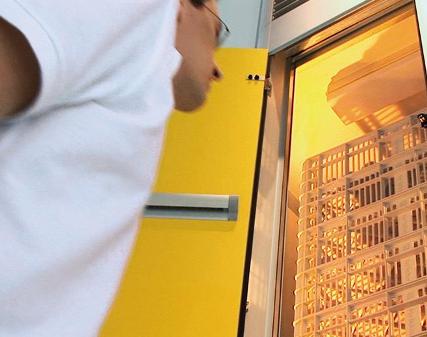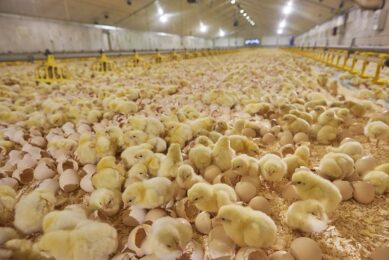The hatchery of the future

Poultry consumption is expected to increase substantially in the coming decades as a result of world population growth. Along with other influencing factors in poultry production, the design of hatcheries must be based on this changing and growing demand. In this article, let us predict the trends towards 2034.
By Bouke Hamminga, Pas Reform Hatchery Technologies, Zeddam, the Netherlands
By 2034, more than eight billion people will live on this planet. This growth signals a 50% increase in demand for food over the next 25 years. During this time, experts say that consumption of poultry will outstrip beef, pork and lamb, without puts climbing to 130 billion tonnes a year.
The US, China, Brazil, the EU, Mexico and Russia now account for more than 70% of world poultry production, with Brazil and the US dominating 80% of global exports. By 2034, India will have joined this ‘super group’ of producers, combining with China to boost Asia’s dominance of global poultry consumption and production.
Industry output will grow by about one billion chicks per year to an estimated 70 billion day-old chicks per annum, representing an increase of 20 million day-olds every week, of which 50% will be produced in Asia and 30% in the US and Latin America. Extrapolated over the next 25 years, global production will expand by a further 600 million day-old chicks (from the 800 million chicks produced currently) to a staggering 1.4 billion chicks per week.
Super hatcheries on the way
Today’s automated hatcheries produce up to 1.5 million chicks per week in four equal hatches. To keep pace with demand, production will have to scale-up and we are going to see a shift to massive, industrial complexes, or ‘super hatcheries’, where up to six million day-olds are hatched every week in six routine hatches of a million chicks a day. Plans for these enormous hatchery complexes are already on the drawing board!
Efficiency throughout the production chain means targeting repeatable results:>95% hatch of fertiles per batch, with first week mortality reliably below 0.5% and a hatch window of less than 12 hours.
Alongside the industrial segment, a niche will develop for a more robust, rustic broiler. This will be triggered in some areas for reasons of animal welfare, in others by a preference for the quality and taste of tougher meat. This market is growing quite rapidly in Europe and could account for 10% of broiler production by 2034.
The impact of poultry genetics
Over the next 20-30 years, geneticists predict continuing demand for higher final bodyweight and lower feed conversion. The negative correlation between high juvenile growth rate and reproductive performance, and selection for specific traits in pure breeding lines, will produce new challenges in incubation. Selection for higher growth increases metabolic growth in the embryo. This, in turn, increases metabolic heat production by the embryo, making it more complex to achieve optimum incubation.
Increased metabolic heat production by the embryos demands greater cooling capacity – a key area for further change and progress in incubation technologies and practice. Today, there are very few machines on the market with sufficient cooling capacity to optimise incubation in line with genetic progress.
In large incubators (>100,000 eggs capacity), it is not unusual to find mixed batches in one machine, differing in egg size, breed type, parental age and egg storage time.
Thinking modular
Despite this contemporary practice, there is still only one setter on the market currently specified to deliver modular incubation. This modular, single-stage machine steers up to six set points simultaneously, enabling the use of batch-specific, step down temperature programmes. The last three days of incubation are critical to determining, fine-tuning and reducing the hatch window, which is pivotal to delivering uniformity.
With modular incubation we can register every parameter of the hatch result to predict the needs of future batches. Therefore, to accommodate the large-scale management of temperature, humidity and CO2 without compromising the specific incubation profiles of differing batches, the super hatchery – perhaps with capacities greater than 38,400 eggs per hatcher – will be modular in its design and layout.
Advanced management, enhanced uniformity
New techniques will surface that will allow greater control over embryonic growth to influence uniformity. Work has already begun on Circadian Incubation™ (patent pending) where incubation temperature profiles are influenced towards the end of the cycle to improve post-hatch robustness.
Other new developments will include increased roles for both ultrasound and micrometry egg shell analysis: grading shell thickness by mass to influence the hatch window and day-old chick uniformity. Automatic in-ovo sexing techniques will also come into play to identify the sex of a chick pre-hatch so that the layer industry need no longer produce unwanted males, which is an important step in terms of animal welfare.
In the future we can expect a rise in the use of in ovo-technologies and practice, not only in the more widespread use of in-ovo vaccination, but also for the feeding of products developed to stimulate late embryonic growth and intestinal tract development. Known as ‘nutri-genomics’, this will assist in creating robust day-old chicks, better prepared to express their genetic potential from the moment of hatch.
Artificial intelligence
More prolific use of advanced hatchery software will grant access to programmes that fully integrate, translate and mobilise the wealth of data available in the modern hatchery. Most of today’s software solutions merely record historic results. With the integration of Artificial Intelligence, new programmes will analyse recorded data to define and deliver specific incubation environments, as well as predict the needs of future batches.
The relationship between egg variation, incubation temperature profiles, length of the hatch window – and their combined contribution to delivering reliable uniformity – will be the focus of further research over the next couple of decades, for success in the highly automated production environments of the future.
There is only one machine on the market today measures hatch peak, indicating spread of hatch by the spontaneous rise of humidity and CO2. This technique is used routinely to evaluate hatch times, producing reduced hatch peaks of ±12 hours through informed management. In an expanding global sector, it will be possible to apply such techniques to a massively expanded database.
Track and trace
Consumer concerns over the origin and safety of food are a feature of modern life that is here to stay. To meet these concerns, retailers and fast food chains will demand complete traceability from their suppliers, especially for fresh produce, meat and poultry products.
Hatchery information systems will trace (backwards) and track (forward) the movement of hatching eggs, from breeder farm to rearing farm. Batches of eggs will be traceable to specific areas of the setter or hatcher, and even allocated to a particular customer. An increase in the use of JIT (Just In Time) systems for the treatment of chicks during take-off will ensure that time lapsed from hatchery to farm placement is minimal.
New hatchery systems will not only streamline and improve control in the hatchery, but also register the movement of hatching eggs, alert the hatchery manager automatically to alarm events, and provide predictive management tools for hatchery maintenance and the management of spares and stock. They will actively contribute to achieving operational reliability, greater productivity and increased uptime. Interactive web-based portals will strengthen traditional support systems, delivering a range of practical, online, ‘round the clock’ services for the hatchery manager, to help improve daily practice, performance and results.
Energy saving cutting costs
Energy saving in incubation contributes not only to the hatchery’s efficiency and operational costs, but also to improving the environment in the broader, global context. Energy costs, as a factor in the cost of producing a day-old chick, have increased by more than 50% since 2000.
Developing embryos produce a great deal of heat, and will produce more in the future. A hatchery producing 800,000 day-old chicks per week in a European climate will typically use 2.4 million kwh per year. The developing embryos in that same hatchery will produce 2.9 million kwh per year! In the current global economic climate, this is a valuable calculation that will spawn new developments for the hatchery of the future: higher efficiency motors, improved air handling units, the re-use of embryonic heat to provide for the hatchery’s needs. We will also see the earth’s warmth and natural cooling capacity directed to the running of chillers, boilers and heat pumps.
A predictable, uniform, super-sized future
Scaling-up production to meet increased consumer demand for poultry and poultry meat products means adopting fully automated processes. To deliver on the bottom line, automated production demands birds of uniform size and weight for processing. From the hatchery to the farm, the ability to stimulate predictable, uniform growth and development in our flocks is therefore central to future growth. And with the delivery of uniform, healthy, day-old chicks from the hatchery, everyone –from farm to processor – can look forward to improved performance.
Low feed conversion and mortality, rapid growth, excellent processing yield and maximum egg production will all echo positively throughout the poultry production chain – in a super-sized future.
Join 31,000+ subscribers
Subscribe to our newsletter to stay updated about all the need-to-know content in the poultry sector, three times a week. Beheer
Beheer








 WP Admin
WP Admin  Bewerk bericht
Bewerk bericht